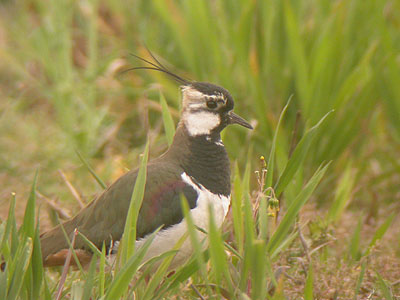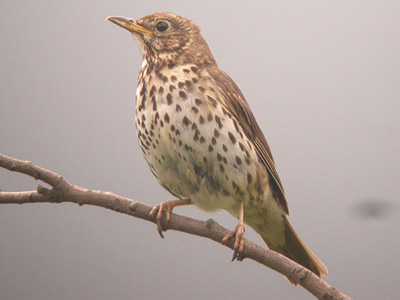

| Eakring Birds |
| Bird surveys 2002 |
| Due to other commitments during the Spring and Summer months, a full-scale breeding bird survey was found to be both impossible and impractical. The Surveys page for 2002, thus takes a more selective look at the continuing fortunes of certain species/families. | ||
| .... | ||
 |
Although coverage was
virtually daily, it was limited by time constraints.
Nevertheless, much information was still collected by the
systematic recording and mapping of territorial males and
breeding pairs. Breeding wildfowl in 2002 2002 was a year of continued success for most species. There were also some surprises in the form of first time proven/actual breeding attempts by Mandarin, Shelduck (Eakring Flash) and Little Grebe (Kersall). Ruddy Ducks remained in the area throughout the Summer, but again failed to produce young, although breeding was certainly attempted and probably for the second consecutive year. Shown in the two tables below are the breeding wildfowl pair/brood counts for the area since 1998. Whilst breeding totals of Mallard have remained reasonably consistant in the five study years, there has been a slight increase in numbers of both Tufted Duck and Gadwall. 2002 saw three pairs of the latter species breed: quite a feat considering water size here compared to other larger waters within the county. |
|
| .... | ||
It was a good year in general for most breeding wildfowl here, with all having high percentage brood-rearing rates with the exception of Shelduck. First appearing with a healthy brood of nine, all but one were predated by foxes. For most of the time the young were left unattended by the female, only returning to roost there late evening. As such, the young were very independent from an early age, whereas the young of other ducks, remained under close protection by adults. The fact that Shelduck bred here was in itself not entirely surprising, as a pair have been present in the area at this time each year since 1998. In all previous years, nesting most likely occurred at nearby Bilsthorpe Pit Top, although prospecting for suitable nesting sites here had been noted previously. Mandarin produced what is probably only the second brood ever reared in the county. The first record coming in 2000. A total of four young were not seen until early September, with breeding coming from a secret location. |
||
| Song Thrush and Skylark continue population rises | ||
| Breeding bird survey
results revealed that Song Thrush and Skylark populations
are continuing to rise, maintaining increases that were
initially noted in 1999, a year on from the first ever
survey of the area's breeding species. Unfortunately,
this trend has not been mirrored by other resident
farmland species, with populations of Grey Partridge
critically low (just one sighting of a pair this year at
Eakring Field Farm) two pairs of Tree Sparrow and
Bullfinch still at around four pairs. Lapwing are faring
little better, with four pairs currently at one site in
the Red Hill area. The current number of breeding Song Thrush pairs, has risen from 15 in 1998 to 26 in 2002. The Sky Lark has likewise increased it's pair counts from 10 in the 1998 survey, to 24 in 2002. Whilst this is a most welcome trend, it has to be remembered that these figures still fall well below those of 20 and 30 years ago. These
increases seem largely due to a natural comeback by both
species, rather than being aided by conservation measures
such as set-aside. Complete set-aside fields are
presently being largely ignored as breeding sites by Sky
Larks and fields may be better populated if instituted on
a permanent basis, rather than the current one-year
policy. |
 |
|
| The evidence for this may lie in the fact that
Sky Lark males are presently occupying all ten of the
territitories used in 1998 and all but one, still nest in
cultivated fields except for one pair which has recently
occupied the area's only area of permanent set-aside near
Hare Hill Wood. The recent laying down of set-aside
strips will undoubtably aid a larger Sky Lark increase in
the future, but more farms need to be encouraged to do
this. The Song Thrush's stronghold is Eakring village (remaining so since 1998) but has increased it's range here to now include all areas of deciduous woodland and sites consisting of dense scrub such as Parkhill Copse. The largest spread of growth has come to the west of Kersall village, continuing into the Eakring Meadows complex, but suitable habitat in the center of the recording area still remains unoccupied. Overall breeding bird summary Despite the continuing success in recent years of both Skylark and Song Thrush, several other species continued to exist on the basis of extremely fragile breeding populations. Yellow Wagtail (2 pairs) Tree Sparrow (2 pairs) Turtle Dove (2 pairs) Grey Partridge (3 pairs) Garden Warbler (2 pairs) Goldcrest (1 pair) and both Marsh and Willow Tit (2 pairs each) all remain just such species. Lapwing were one of only two failures during the season (despite four pairs attempting breeding in both Bean and Sugar-beet fields) the other being the sporadically breeding Grasshopper Warbler. Despite a male taking up territory at Eakring Flash for over a week, it remained un-paired and soon left the site. This was however, the first occupation by Grasshopper Warbler at Eakring Flash, where continuing scrub invasion and rank vegetation, looks set to provide further opportunities in the coming years. The advancement of the Willow scrub at Eakring Flash has also surprisingly, yet to attract any Willow Warbler males into taking up territory. This (as with Grasshopper Warbler) may only be a matter of time. Other warblers again produced satisfactory breeding counts, some increasing on previous years. Garden Warblers were traditionally restricted to just a couple of pairs at two locations. |